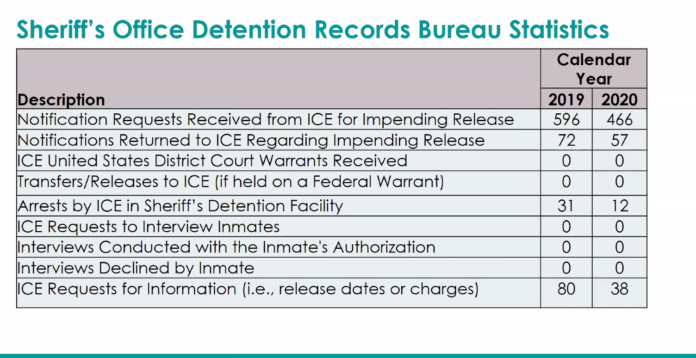
In 2019 the Sonoma County Sheriff’s Office responded to 72 of the 596 U.S. Immigration and Customs Enforcement (ICE) requests for impending inmate release information and in 2020 the Sheriff’s Office responded to 57 of the 466 information requests, ultimately resulting in 31 arrests by ICE in 2019, and 12 in 2020 according to data from the Sonoma County Sheriff’s Office Detention Records Bureau.
The data was presented to the public during the Sonoma County Board of Supervisors TRUTH Act Forum held on Tuesday, Feb. 9.
As approved by the state legislature and signed into law by then Gov. Jerry Brown in 2016, the TRUTH Act — also known as the Transparent Review of Unjust Transfers and Holds Act — requires local governing bodies in which local law enforcement has provided any ICE access to an individual to hold a community forum to receive and consider public comment.
“The Sheriff’s Office provides inmate release dates to ICE and the public in compliance with state law, including the SB 54 California Values Act. Inmates with their representatives are able to review these information requests,” said Nikolas Klein, an analyst with the Sonoma County Administrator’s Office.
SB 54, which was passed in 2017, has several main components which prevents mass deportations, increases immigrants’ protection, establishes safe zones for immigrants and limits the way state and local officials can cooperate with ICE.
According to Klein, the Sheriff’s Office routinely receives inquiries from ICE asking for release dates for individuals in local custody.
“To comply with SB 54, the Sheriff uses a complicated decision matrix to determine how to respond to ICE’s request. Applying the SB 54 matrix criteria, the Sheriff ultimately responded to 72 requests in 2019, and 57 in 2020, approximately 12% of the total requests in each given year. The Sheriff’s response to ICE inquiries ultimately resulted in 31 arrests in 2019 and 12 in 2020,” Klein said.
Klein said the downward trend is largely due to COVID-19 and the lower average daily inmate population of the Sonoma County Jail.
Although the figures have gone down in a year, several public speakers urged the Sonoma County Board of Supervisors during the forum to take action on making Sonoma County a sanctuary county.
A sanctuary municipality limits their cooperation with the national government’s effort to enforce immigration law through local laws, ordinances, regulations or policies that obstruct immigration enforcement and protect inmates from ICE either by refusing to or prohibiting agencies from complying with ICE detainers, or otherwise impeding communication or information exchanges between their personnel and federal immigration officers.
According to county council, the Sheriff’s office does not enforce federal immigration law; it does not deport anyone; it does not conduct immigration sweeps; it does not contact someone based only on his/her immigration status; it does not contact ICE to determine an immigration status; it does not accept immigration violation complaints; and it does not have authority over ICE.
The Sheriff’s Office does provide release dates to ICE pursuant to state law and to the public as requested.
Aside from release dates, the Sheriff’s Office also receives other information requests from ICE, such as booking and warrant information.
Eight booking information requests were made by ICE in 2019 and zero of the requests were returned to ICE by the Sheriff. Two booking information requests were made by ICE in 2020 and none of the requests were returned.
ICE requested eight crime reports from the Sheriff’s Office in 2019, seven of which were returned to ICE from the Sheriff. In 2020 ICE requested 15 crime reports, 10 of which were returned to ICE.
Following the data presentation District 3 Supervisor Chris Coursey asked Sonoma County Sheriff Mark Essick if anything in the statistics represents any unjust transfers or holds.
“It is my certification to you and to the public that we are in compliance with SB 54 and that we have not made any unjust transfers in 2019 or 2020. I will couch that with one exception, and that was in 2019. We had a notification error in which we had a clerical error by one of our staff members where we received a request from ICE, the matrix was completed and it was completed in error and a notification was returned to ICE that that person was in custody. It did not result in an arrest and it did not result in a deportation,” Essick said.
Essick said the incident was investigated internally and shared with IOLERO and corrective actions were taken internally to prevent such a mistake from happening again.
Five inmate reviews, requests by an inmate or an inmate’s representative to review the basis for determination of an ICE notification, were conducted in 2019. One review yielded a reversal of an ICE notification. Four inmate reviews were conducted in 2020 and one was reversed.
During the public comment portion of the forum Renee Saucedo, the program director for the Graton Day Labor Center/Women’s Labor and Solidarity Alliance (ALMAS), urged the county to look at sanctuary ordinances.
“Sonoma County shouldn’t share inmate release dates to ICE,” she said.
Rachel, a Sebastopol resident, shared Saucedo’s sentiment and said there should simply be a county policy to not interact at all with ICE. Another West County resident agreed.
“It is good it has gone down, but it should be at zero,” he said, referring to the TRUTH Act data that was presented earlier.
During supervisor comments District 1 Supervisor Susan Gorin said she’s heard of instances where ICE arrests individuals before they go to court. Such an incident occurred in Sonoma County on Feb. 18, 2020 when ICE agents arrested three individuals in and around the Sonoma County Superior Court.
The Sheriff’s Office did not collaborate with ICE agents in any of the arrests, Essick said in a press release that was released at the time of the incident.
Sonoma County District Attorney Jill Ravitch, Public Defender Kathleen Pozzi, and then county counsel Bruce Goldstein heavily condemned the arrests, which garnered local and national media attention.
Goldstein stated in the same press release that “ICE’s actions are lawless in that their actions are carried out without judicial warrants and violate recently passed state law prohibiting civil arrests at a courthouse. Rather than protect our community, these immigration arrests undermine our system of justice.”
Gorin asked if these types of ICE sweeps will continue under the new Biden Administration. Sonoma County Deputy Public Defender, Gamaliel Galindo, said changes are already happening around ICE policy.
“On Jan. 20 President Biden signed an executive order and then the acting secretary of the department of homeland security, which oversees ICE, wrote a memo changing the priorities for detention and for giving out notifications in our jails. So technically, as of Feb. 1, it affects our inmate population, and what that (executive) order specifically says is that only inmates that have what’s called an aggravated felony and pose a danger to society only are those people on the priority list to be deported. So, what that means is that they’ve already narrowed the number of notices that they are supposed to send to our jails… And we are expecting further changes that will impact what we do,” Galindo said.
The county also has a growing support network — called the Sonoma County Secure Families Collaborative — for the county’s immigrant population.
In 2016, “The board supported and approved the launch of the Sonoma County Immigration Initiative to keep the county’s immigrant population safe, informed and connected to local government efforts to protect them,” said Alegria De La Cruz, the head of the Sonoma County Office of Equity.
Following an informal needs assessment it became clear that there was almost a complete lack of low-and no-cost immigration deportation defense services in Sonoma County according to Cruz.
She said the need for these legal services became even more apparent with the end of the DACA (Deferred Action for Childhood Arrivals) program.
“The ultimate goal of the collaborative was to provide immigrant residents and their families with an integrated system of legal and other resources. In early 2018, the Sonoma County Immigration Initiative released a request for proposals and after successful negotiations with responders we created and funded the Sonoma County Secure Families Collaborative, which built on the strength and expertise of existing organizations, including vital immigrant defense and advocacy services, The University of San Francisco Law School deportation clinic and Catholic Charities,” Cruz said. “We are now in year three and we have served over 600 individuals and their families to secure a safer and healthier existence here in Sonoma County and in 2021 the collaborative is well positioned to continue to provide the critical legal assistance needed by our community.”
The collaborative is also working on expanding its services to address mental health needs, the needs of those adversely affected by COVID-19, and to better address the needs of those in the Sonoma Valley and in Petaluma.
To view the forum in its entirety, visit https://sonoma-county.legistar.com/Calendar.aspx .







